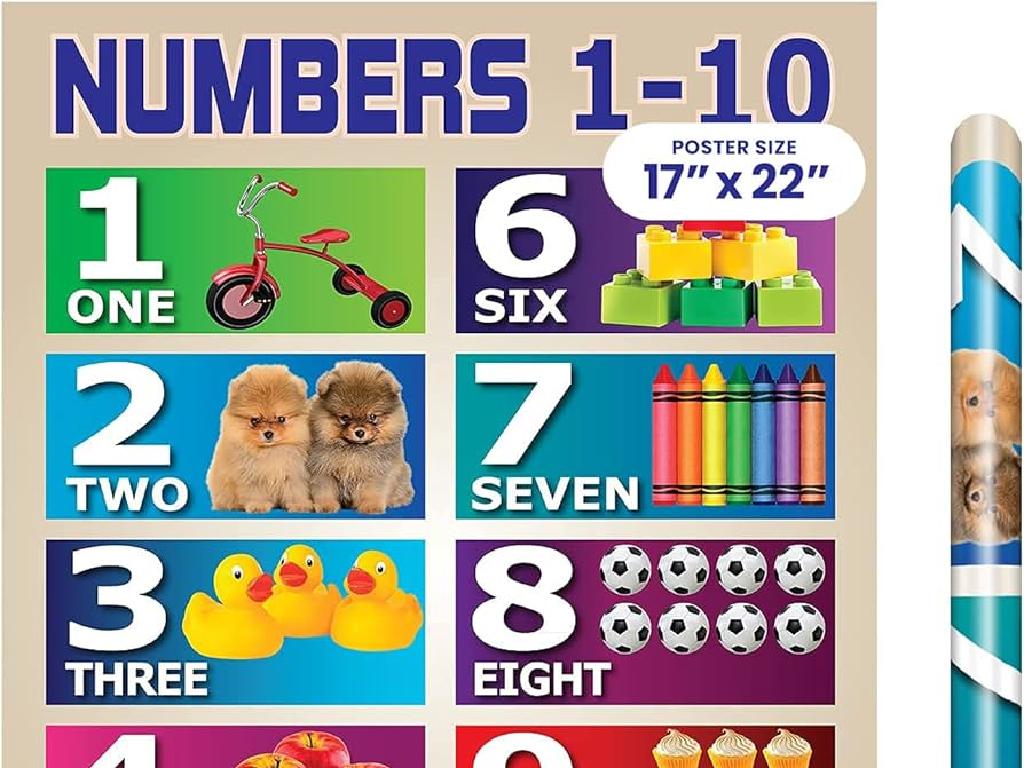Divide By 2
Subject: Math
Grade: Third grade
Topic: Division Skill Builders
Please LOG IN to download the presentation. Access is available to registered users only.
View More Content
Today’s Adventure: Divide by 2!
– Division means sharing equally
– If we have 6 apples and share them with a friend, we each get 3.
– Dividing by 2 creates two groups
– Like splitting 10 cookies between 2 people, each person gets 5.
– Real-life division examples
– Sharing snacks, organizing toys, or splitting chores with a sibling.
– Division is a key math skill
|
This slide introduces the concept of division as a form of sharing equally among a certain number of groups, in this case, two. Start by explaining that division is simply dividing something into equal parts. Use tangible examples like sharing food or toys to illustrate the point. Emphasize that learning to divide by 2 is not only useful in school but also in everyday situations, such as sharing items fairly between two people. Encourage students to think of division as a useful tool they will use often, making it an essential skill to master. Provide additional examples and possibly a hands-on activity where students can physically divide objects into two groups to reinforce the concept.
Understanding Division: Divide by 2
– Division is sharing equally
– Imagine dividing cookies among friends so everyone gets the same amount.
– Splitting numbers into groups of 2
– How many pairs can you make from a set of items?
– Learn key vocabulary: Dividend, Divisor, Quotient
– Dividend is what we divide. Divisor is the number we divide by (2). Quotient is the result.
– Practice with examples
– We’ll divide different numbers by 2 to see how it works.
|
This slide introduces the concept of division to third-grade students by relating it to the familiar activity of sharing cookies equally. It’s important to explain that division is essentially grouping numbers into smaller, equal sets in this case, into groups of two. Introduce the terms ‘dividend’ (the number being divided), ‘divisor’ (the number we are dividing by, which is 2 for this lesson), and ‘quotient’ (the result of the division). Use simple examples like dividing 10 apples among 2 baskets to illustrate the concept. Encourage students to think of division as a fair way to distribute items and to understand that the quotient represents how many items each group receives. Provide several examples for the students to work through, ensuring they grasp the concept of dividing by 2.
Dividing by 2: Making Equal Groups
– Dividing creates equal groups
– Example: 6 cookies shared by 2
– If we have 6 cookies and 2 friends, how many cookies does each friend get?
– Each group gets the same amount
– We split 6 into 2 groups evenly, so each group has 3 cookies
– Division by 2 is fair sharing
|
This slide introduces the concept of division by 2 as a way of creating two equal groups. Use the example of sharing cookies between friends to make the concept relatable and easier to understand. Emphasize that division is essentially fair sharing, where each group ends up with the same number of items. Encourage students to visualize the division process and to use physical objects like counters or drawings to practice dividing by 2. This will help them grasp the concept of equal distribution and prepare them for more complex division problems.
Dividing Apples Equally
– Start with 8 apples
– Divide them by 2
– Splitting 8 apples into 2 groups
– How many apples per group?
– Each group should have the same number
– Visualize equal groups
– Imagine putting apples into two baskets
|
This slide is aimed at helping students visualize the concept of division by using a relatable example of dividing apples. Start by showing 8 apples, then demonstrate how to divide them into two equal groups. Ask the students how many apples each group would have to ensure they understand that division is about making equal groups. The visual aid could be a simple drawing of apples being grouped into two sets. Encourage the students to draw their own examples or use objects in the classroom to practice this concept. This hands-on activity will help solidify their understanding of dividing by 2.
Try It Together: Dividing Objects by 2
– Class activity: Divide items by 2
– Work with a partner to share equally
– Discuss your observations
– Did the items split into two equal groups?
– Understanding division by 2
– Division by 2 splits things into two equal parts
|
This slide introduces a hands-on class activity where students will work in pairs to physically divide a set of objects by 2, fostering a practical understanding of division. The goal is for students to observe that dividing by 2 creates two equal groups. After the activity, lead a discussion to help them articulate their observations and reinforce the concept that division is essentially sharing equally. Possible activities include dividing a set of counters, sharing pencils, or splitting pieces of fruit. Encourage students to explain their thought process and what they noticed during the activity. This will help them grasp the concept of halving and the fundamental principle of division.
Division is Everywhere!
– Division in daily life
– Pizza slices & shoe pairs
– If a pizza has 8 slices, how many people can have 2 slices each?
– Division’s role in everyday tasks
– Division helps us share things equally and understand quantities.
– Practice with real examples
– Try dividing toys or snacks into 2 equal groups at home.
|
This slide aims to show students that division is not just a mathematical concept, but a part of our everyday lives. Use tangible examples like sharing pizza slices or pairing shoes to illustrate how division works and why it’s useful. Explain that division helps us split things into equal parts, whether it’s food, objects, or time. Encourage students to find examples of division at home or in the classroom and to practice dividing various items into two groups. This will help them see the practical application of division and understand its importance in daily activities.
Division Practice: Divide by 2
– Solve division problems together
– Example: 10 ÷ 2 = ?
– 10 divided by 2 equals 5. How many groups of 2 make 10?
– Make two equal groups
– Visualize splitting items into 2 same-size groups
– Understand division by 2
– Division by 2 means finding out how many times 2 fits into a number
|
This slide is aimed at providing practice problems for students to reinforce their understanding of division by 2. Start by solving a few problems as a class to demonstrate the process. Use the example provided to show how to divide a number into two equal groups. Encourage students to visualize the division process by physically grouping objects or drawing pictures. Emphasize that dividing by 2 is essentially finding out how many pairs can be made from a number. Provide additional practice problems for students to solve independently or in pairs, and be ready to assist anyone who needs help.
Game Time: Division Dash!
– Teams race to solve problems
– Divide items by 2
– If you have 10 apples, how many do 2 friends get each?
– First team to finish wins
– Earn points for correct answers
|
This interactive game is designed to help students practice dividing by 2 in a fun and competitive way. Divide the class into small teams and provide each team with a set of division problems involving dividing various items by 2. Use tangible items like counters, blocks, or pictures to make it more engaging for third graders. The first team to solve all their problems correctly wins a point. Keep score and encourage teams to work together to find the answers. This activity will reinforce the concept of division by 2 and improve problem-solving skills. Possible variations of the activity could include using flashcards, timed races, or relays to keep the energy high and students engaged.
Wrapping Up: Dividing by 2
– Understanding division by 2
– We learned how to split things evenly into two groups.
– Division’s role in everyday life
– Helps us share equally, like cookies or toys with a friend.
– Key terms: Dividend, Divisor, Quotient
– Dividend: number we divide. Divisor: number we divide by. Quotient: the answer.
– Practice makes perfect
|
In this session, we’ve explored the concept of dividing by 2, which is essentially splitting a number into two equal parts. We’ve discussed how division is a useful skill in daily life, such as sharing items equally among friends or family. We’ve also reviewed important vocabulary like ‘dividend’, which is the number being divided; ‘divisor’, which is the number we divide by; and ‘quotient’, which is the result of the division. To reinforce these concepts, encourage students to practice with different numbers and real-life scenarios where they can apply division by 2. Remember, consistent practice is key to mastering division!
Class Activity: Division Art
– Create an art piece on division by 2
– Use stickers or stamps to show division
– For example, use 10 stickers and divide them into 2 groups to show 10 divided by 2.
– Share your art and explain your division
– Understand division by 2 through art
|
This activity is designed to help students understand the concept of division by 2 in a fun and creative way. Provide students with materials like stickers, stamps, or cut-out shapes. They should create an art piece that visually represents the division of a number by 2. Encourage them to think about how they can show equal groups in their art. After completing their artwork, each student will present their piece to the class and explain how it represents division by 2. This will reinforce their understanding and allow them to practice their division skills. Possible variations of the activity could include using different numbers of objects, creating a collage, or even a group project where students work together to divide a larger number of items.





